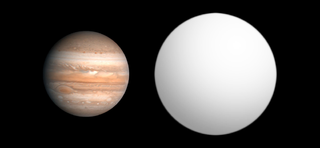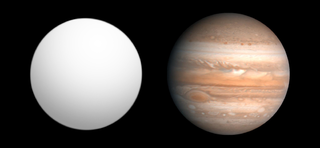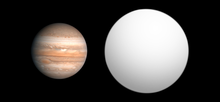
HAT-P-1b is an extrasolar planet orbiting the Sun-like star HAT-P-1, also known as ADS 16402 B. HAT-P-1 is the dimmer component of the ADS 16402 binary star system. It is located roughly 521 light years away from Earth in the constellation Lacerta. HAT-P-1b is among the least dense of any of the known extrasolar planets.
HD 147506, also known as HAT-P-2 and formally named Hunor, is a magnitude 8.7 F8 dwarf star that is somewhat larger and hotter than the Sun. The star is approximately 419 light-years from Earth and is positioned near the keystone of Hercules. It is estimated to be 2 to 3 billion years old, towards the end of its main sequence life. There is one known transiting exoplanet, and a second planet not observed to transit.

HAT-P-2b is an extrasolar planet detected by the HATNet Project in May 2007. It orbits a class F star HAT-P-2,, located about 420 light-years away in the constellation Hercules.
The Hungarian Automated Telescope Network (HATNet) project is a network of six small fully automated "HAT" telescopes. The scientific goal of the project is to detect and characterize extrasolar planets using the transit method. This network is used also to find and follow bright variable stars. The network is maintained by the Center for Astrophysics | Harvard & Smithsonian.

HAT-P-4b is a confirmed extrasolar planet orbiting the star HAT-P-4 over 1000 light years away in Boötes constellation. It was discovered by transit on October 2, 2007, which looks for slight dimming of stars caused by planets that passed in front of them. It is the fourth planet discovered by the HATNet Project. It is also called BD+36 2593b, TYC 2569-01599-1b, 2MASS J15195792+3613467b, SAO 64638b.

HAT-P-7b is an extrasolar planet discovered in 2008. It orbits very close to its host star and is larger and more massive than Jupiter. Due to the extreme heat that it receives from its star, the dayside temperature is predicted to be 2,630–2,880 K K, while nightside temperatures are 2,211–2,238 K. HAT-P-7b is also one of the darkest planets ever observed, with an albedo of less than 0.03—meaning it absorbs more than 97% of the visible light that strikes it.

WASP-7b is an extrasolar planet discovered in 2008. This 5-day period planet is slightly smaller than Jupiter, roughly the same mass and more dense.

WASP-8b is an extrasolar planet orbiting the star WASP-8A in the constellation of Sculptor. The star is similar to the Sun and forms a binary star with a Red dwarf star (WASP-8B) of half the Sun's mass that orbits WASP-8A 4.5 arcseconds away. The system is 293 light-years (90 pc) away and is therefore located closer to Earth than other star systems that are known to feature planets similar to WASP-8b. The planet and its parent star were discovered in the SuperWASP batch -6b to -15b. On 1 April 2008, Dr. Don Pollacco of Queen's University Belfast announced them at the RAS National Astronomy Meeting.
WASP-11/HAT-P-10 is a binary star. It is a primary main-sequence orange dwarf star. Secondary is M-dwarf with a projected separation of 42 AU. The system is located about 424 light-years away in the constellation Aries.

CoRoT-3b is a brown dwarf or massive extrasolar planet with a mass 21.66 times that of Jupiter. The object orbits an F-type star in the constellation of Aquila. The orbit is circular and takes 4.2568 days to complete. It was discovered by the French-led CoRoT mission which detected the dimming of the parent star's light as CoRoT-3b passes in front of it.
HAT-P-4 is a wide binary star consisting of a pair of G-type main-sequence stars in the constellation of Boötes. It is also designated BD+36°2593.
HAT-P-11, also designated GSC 03561-02092 and Kepler-3, is an orange dwarf metal rich star about 123 light-years away in the constellation Cygnus. This star is notable for its relatively large rate of proper motion. The magnitude of this star is about 9, which means it is not visible to the naked eye but can be seen with a medium-sized amateur telescope on a clear dark night. The age of this star is about 6.5 billion years.

HAT-P-11b is an extrasolar planet orbiting the star HAT-P-11. It was discovered by the HATNet Project team in 2009 using the transit method, and submitted for publication on 2 January 2009.
HAT-P-8 is a magnitude 10 star located 700 light-years away in Pegasus. It is a F-type star about 28% more massive than the Sun. Two red dwarf companions have been detected around HAT-P-8. The first has a spectral type of M5V and has a mass of 0.22 M☉. The second is even less massive, at 0.18 M☉, and its spectral type is M6V.
HAT-P-13, also known as GSC 03416-00543, is a G-type main sequence star approximately 800 light-years away in the constellation Ursa Major. In 2009 it was discovered that this star is orbited by two massive planets, the innermost of which transits the star. This was the first known example of an extrasolar transiting planet with an additional planet in the same system.

HAT-P-14b, officially named Sissi also known as WASP-27b, is an extrasolar planet located approximately 224.2 ± 0.6 parsecs (731.2 ± 2.0 ly) away in the constellation of Hercules, orbiting the 10th magnitude F-type main-sequence star HAT-P-14. This planet was discovered in 2010 by the HATNet Project using the transit method. It was independently detected by the SuperWASP project.
HAT-P-24 is an F8 dwarf star about 400 parsecs away. A planet was discovered with the transit method by the HATNet Project in 2010. HAT-P-24b, is a typical hot Jupiter orbiting in only 3 days.
HAT-P-24b is an extrasolar planet discovered by the HATNet Project in 2010 orbiting the F8 dwarf star HAT-P-24. It is a hot Jupiter, with a mass three quarters that of Jupiter and a radius 20% larger.
HAT-P-17 is a K-type main-sequence star about 92.6 parsecs (302 ly) away. It has a mass of about 0.857 ± 0.039 M☉. It is the host of two planets, HAT-P-17b and HAT-P-17c, both discovered in 2010. A search for a binary companion star using adaptive optics at the MMT Observatory was negative. A candidate companion was detected by a spectroscopic search of high-resolution K band infrared spectra taken at the Keck observatory.
HD 146389, is a star with a yellow-white hue in the northern constellation of Hercules. The star was given the formal name Irena by the International Astronomical Union in January 2020. It is invisible to the naked eye with an apparent visual magnitude of 9.4 The star is located at a distance of approximately 446 light years from the Sun based on parallax, but is drifting closer with a radial velocity of −9 km/s. The star is known to host one exoplanet, designated WASP-38b or formally named 'Iztok'.









